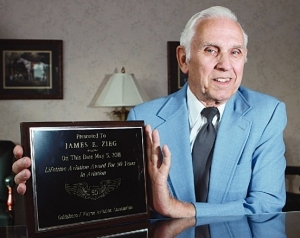Still up in the air after 56 years
By Ty Johnson
Published in News on May 8, 2011 1:50 AM

News-Argus/MICHAEL BETTS
James Zieg smiles after receiving his Lifetime Achievement Award from the Goldsboro-Wayne Aviation Association.
He remembers piloting a B-52 laden with nuclear weapons into combat areas in Vietnam and enemy combatants firing at him as he dropped off troops in a C-7 Caribou.
He remembers flying in 24-hour shifts from the United States to Asia, passing through the Arctic Circle and admiring the Northern Lights.
With his time flying military aircraft over, however, retired Air Force Col. Jim Zieg found he couldn't stay out of the sky, and Thursday, the Goldsboro-Wayne Aviation Association saw fit to honor him with the club's first award for lifetime achievement in aviation.
With 56 years of flying spanning conflicts in Cuba and Vietnam, club president Chad Coker said there was little doubt Zieg was the most deserving member among the association's ranks to receive the inaugural award, but that didn't mean the veteran was exempt from a little ribbing and lighthearted banter during Coker's presentation.
"I'm guessing they didn't have Garmin or XM Weather in the cockpit," Coker said, noting how far technology has come since Zieg first joined the Air Force in 1954.
Zieg was brief in his remarks after Coker spoke, jokingly saying he was anxious to get to the food laid out for a reception, but the veteran said the award overwhelmed him. He did, however, grant Coker's request to talk about his time flying bombers in Vietnam.
"I flew 100 hours a month for six years, but I never got tired of seeing the Northern Lights and Russia," he said.
He logged 600 hours in a B-47 before trying out a Model B B-52 bomber. A pioneer in the dawn of the bomber's military use, he said every flight felt like a test flight, making training a bit scary. He noted that today's B-52s are H models to hint at how experimental his flights were in the early age of the Air Force's most widely known bomber.
Following the presentation, Zieg told tale after tale of his flying exploits, some during wartime, others during training or in his Cessna, as club members gathered around him like children during storytime, peppering him with questions.
There were hushed gasps when he talked of how most of the automated mechanisms in today's aircraft weren't available during his flights across the world. A six-member crew would rotate with three resting while the others flew during the day-long trips, though Zieg said round dial instruments and a lack of autopilot meant that he rarely slept during the flights.
His crews would make the trips twice weekly during some stints of the conflict, and while he said he struggles now to log 100 hours annually in his Cessna, he was spending nearly half of that amount of time in the air weekly at some points in his career.
He has upgraded his Cessna with more modern instruments than the bombers he once piloted and he has traded in combat zones with low ceilings for visiting family in Georgia and Tennessee, but said he hasn't lost his passion for flying.
He recounted how he flew a B-52 on a 15-minute refueling mission out of Seymour Johnson Air Force Base in 1981, just a year shy of his retirement.
"It's like riding a bicycle, you don't forget that," he said.
And though his private plane has about a tenth of the wingspan of the B-47s he started out on, he doesn't mind missions across the Southeast instead of missions to southeast Asia, especially with his wife, Jane, by his side.
"We don't have any trouble flying at all," he said.
